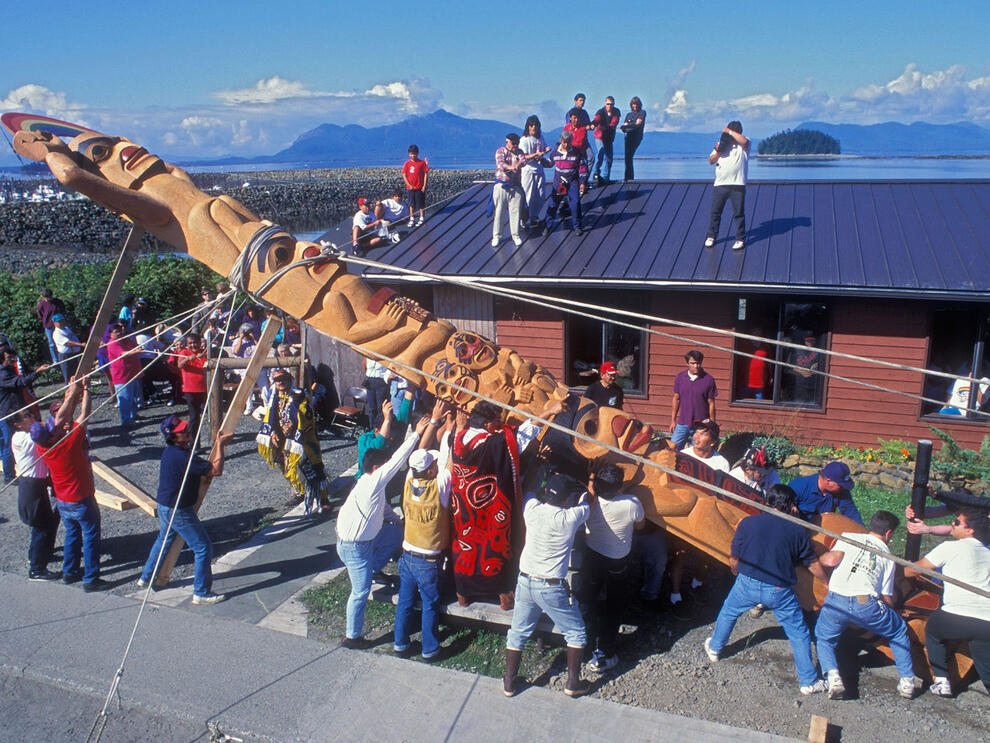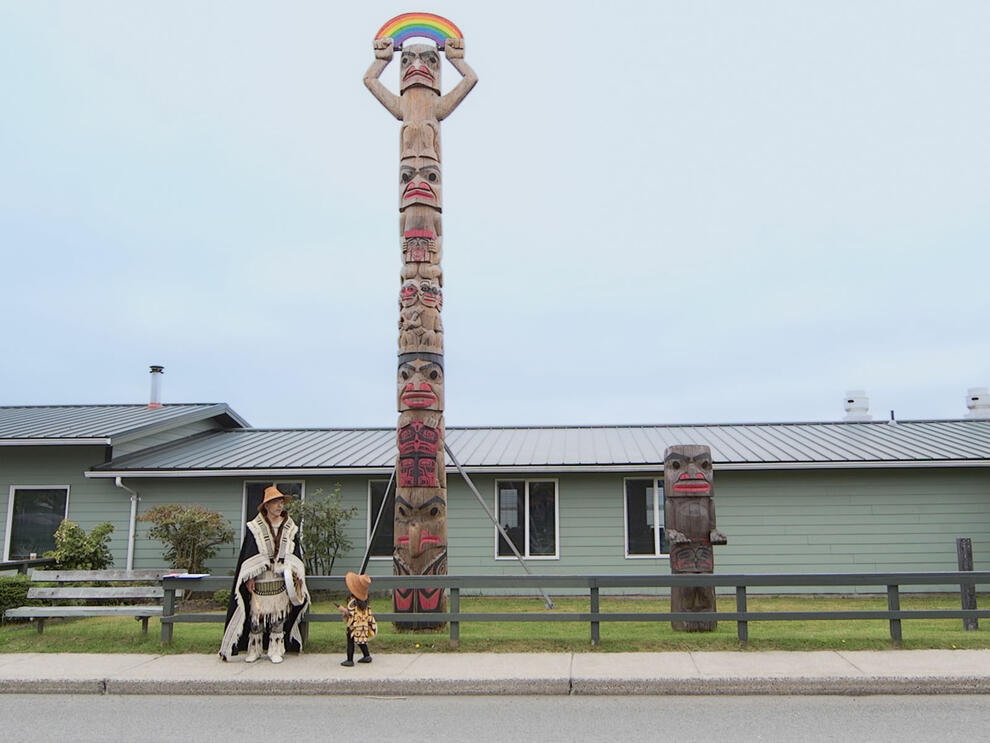Tsimshian
Denis Finnin/AMNH Anthropology catalog 16/252
Selected features from the Northwest Coast Hall.
“Tsimshian” means “people inside the Skeena River.” The Tsimshian, Gitxsan, and Nisg̲a’a people are neighbors along the Skeena and Nass Rivers on the northern coast of British Columbia. These Nations share many traditions and their languages are closely related. Another Tsimshian community is located on Annette Island Reserve, in Metlakatla, Alaska.
Welcome To the Nation: Tsimshian
[Portrait photo of a man in a vest decorated with buttons, holding a beautifully carved rattle.]
NIIS BUPTS’AAN | DAVID BOXLEY (Master Carver, Tsimshian, La̱xsgyiik): Niis Bupts’aan di waayu. Metlakatla, Alaska di wil ‘waatgu. La̱xsgyiik di pdeeg̱u. Lu'aam g̱oodu di wil [unknown].
My name is David Boxley. I'm Tsimshian, from Metlakatla, Alaska. I belong to the Eagle Clan. And I'm very happy to be sitting in front of you today.
Sm’algyax Language
Sm’algyax is the language spoken by Tsimshian people. Use the buttons below to listen and repeat some words and phrases.
‘Niit, nda wila waan | Hello, how are you doing?
gyemsax | feel at home/content/cozy
misoo | sockeye salmon
‘yuusl | small cedar basket
mełiitk | green
Audio credits: First Voices, Ts'msyen Sm'algyax Language Authority
Our language is in danger. When I first moved home 10 years ago there were six Elders who were fluent Sm’algyax speakers in Metlakatla. In 2021, only one is still living. There are probably 80 or 90 more in all of British Columbia. It’s a very precarious situation.
—Huk Tgini’its’ga Xsgiik | Gavin Hudson, Haayk Foundation, Secretary/Treasurer
Tsimshian, Laxsgyiik, Metlakatla, Alaska
One organization working to keep Sm’algyax alive is the Haayk Foundation in Metlakatla, Alaska. According to Co-Founder Huk Tgini’its’ga Xsgiik | Gavin Hudson, its purpose is to save the language, to rapidly create new fluent speakers, and to share, free of charge to the public, any language resources towards that goal.
Haayk Foundation
Metlakatla Potlatch
Brett Peterson/© AMNH
Social, political, and spiritual life revolves around potlatches, or feasts. The purpose of these events varies—the host may call extended family together to settle a debt, for example, or to name a child. Most important, through theater, dance, and song, the host’s clan tells the stories of its origin, history, rights, and privileges. Performers often wear masks, and their awe-inspiring presentations affirm family identity and pass knowledge to new generations.
At potlatches, a dancer dancing the Chief’s headdress or welcome dance traditionally fills the top of their headdress with eagle down, a sign of peace. As they dance, dipping and tossing their heads, the feathers float away and settle on and around the guests.
Metlakatla Eagle Feather Blessing
[Male dancers kneel on the open floor of a large auditorium-like space. A crowd of people surrounds them in chairs and balconies. The dancers wear elaborately woven and decorated blankets and fur headdresses with long tails that drape over their shoulders. Several women in woven, wide-brimmed hats and long, beautifully decorated blankets walk among the dancers and place white down feathers in the crown of the men’s headdresses.]
NIIS BUPTS’AAN | DAVID BOXLEY (Master Carver, Tsimshian, La̱xsgyiik): Everybody in this room knows what the down is for.
[The women leave the dance floor, the men stand, and a drum begins beating. The dancers shake rattles in their hands.]
[DANCERS AND SINGERS SING TO THE BEAT OF A DRUM]
[As the men dance, they shake their heads forcefully, causing the white feathers to float out and scatter across the dance floor.]
[DRUM POUNDS RAPIDLY. RATTLES SHAKE AT A FAST TEMPO.]
[The pace of the drums and rattles increases to a rapid tempo and then come to a pounding, simultaneous stop. The dancers walk off the stage. Feet step across the eagle down remaining on the floor.]
[APPLAUSE]
In 2019, members of this Museum were invited to attend a potlatch in Metlakatla, Alaska. The large ceremonial feast included local food, singing, dancing, drumming, and the giving of names.
Ariel Nevarez/© AMNH
Erin Chapman/© AMNH
Ariel Nevarez/© AMNH
Essential Artistry
Carvers, weavers, and basket makers bring skill and imagination to creating ceremonial pieces. People continue to make such treasures today. Dancing with masks and regalia at feasts brings representations of spirit beings to life.
Despite the importance of songs, in the past, the Tsimshian had few musical instruments. The principal ones were drums, rattles, and whistles—instruments still in use today. In the potlatch video above, you can see dancers with rattles similar to a Raven rattle in the Northwest Coast Hall.
Click on the 3D model below for a closer look.
Name Giving
Some of the most important potlatches take place when a deceased Chief is mourned and a successor inherits the name and position.
Mangyepsa Gyipaayg | Kandi McGilton, artist and co-founder of the Haayk Foundation, explains how names are placed on people in Metlakatla, Alaska.
Mangyepsa Gyipaayg | Kandi McGilton On Name Giving
[Mangyepsa Gyipaayg | Kandi McGilton speaks to an off-camera interviewer.]
MANGYEPSA GYIPAAYG | KANDI MCGILTON (Artist and Co-founder, Haayk Foundation): When somebody’s getting a new name and you place your hand on their shoulder, you say the name out loud three times.
[At a potlatch ceremony, people stand around a woman in a woven, wide-brimmed hat, placing hands on her shoulders.]
MANGYEPSA GYIPAAYG | KANDI MCGILTON: [Repeats Sm’algyax name three times.]
[Mangyepsa Gyipaayg | Kandi McGilton speaks to an off-camera interviewer.]
MANGYEPSA GYIPAAYG | KANDI MCGILTON: It just- it puts the name on the person. And you do this calling out to the spirits to kind of guide and watch over this naming. And then at the end when everybody’s said the name, you stomp the name into the ground. And that’s why you saw everybody stomping their feet after every name.
[Camera pans across spectators applauding and rapidly stomping their feet.]
MANGYEPSA GYIPAAYG | KANDI MCGILTON: If you’re placing a name on somebody, traditionally, it was the father who would put the name on the child or the person.
[At the potlatch ceremony, the woman who received the new name hugs Mangyepsa Gyipaayg | Kandi McGilton and other participants.]
MANGYEPSA GYIPAAYG | KANDI MCGILTON: In modern times, especially for Metlakatla, we’ve adopted this new way of inviting the other three- the opposite clans to do the name placing.
[Mangyepsa Gyipaayg | Kandi McGilton speaks to an off-camera interviewer.]
MANGYEPSA GYIPAAYG | KANDI MCGILTON: And we’ve tried to push for it to be people who have Sm’algyax names.
INTERVIEWER: Do you have a Sm’algyax name?
MANGYEPSA GYIPAAYG | KANDI MCGILTON: I do. Mangyepsa Gyipaayg. It means “Soars High,” because I was- when it was given to me, it was described as everything I do, I put 100% into. And I strive to do my best all the time.
Clans and Crests
Tsimshian society is divided into four matrilineal clans—Gisbutwada (Killer Whale), Laxgyibuu (Wolf), Laxsgyiik (Eagle), and G̲anhada (Raven).
Brett Peterson/© AMNH
Tsimshian people are born into the clan of their mother. Some carved figures are crests that represent a clan or one extended family within a clan. They include Ancestors, supernatural beings, and other entities important in the history and identity of the lineage.
Only people of high social rank could wear amhalaaydm, or frontlets—elaborate head pieces like the one above, which rest on the forehead and are sometimes trimmed with ermine pelts. They represent family crests and tell the history of family lineage. This frontlet depicts an eagle and frog.
Albert Bolton’s Pole
 Tsimshian people in Metlakatla, Alaska, raised the Albert Bolton memorial pole in 1994.
Tsimshian people in Metlakatla, Alaska, raised the Albert Bolton memorial pole in 1994.Lawrence Migdale/PIX/Alamy
 In 2019, master carver Niis Bupts’aan | David Boxley refurbished, repaired, and rededicated the pole.
In 2019, master carver Niis Bupts’aan | David Boxley refurbished, repaired, and rededicated the pole.Erin Chapman/© AMNH
Tsimshian culture bearer Niis Bupts’aan | David Boxley first carved and raised a pole in Metlakatla, Alaska to his grandfather, Albert Bolton, in 1994. Twenty-five years later, he rededicated the pole to express his gratitude.
The rededication of my grandfather’s pole was a way for me to say in front of witnesses, again, thank you. Thank you, grandfather, for raising me and giving me the life I have. My grandfather and grandmother, Albert and Dora Bolton, they’re the reason I am who I am.
—Niis Bupts’aan | David Boxley, Master Carver
Tsimshian, Laxsgyiik, Metlakatla, Alaska
Click through the images to read David’s words about what each section of the pole represents.
Erin Chapman/© AMNH
Erin Chapman/© AMNH
Erin Chapman/© AMNH
Erin Chapman/© AMNH
Brett Peterson/© AMNH
Metlakatla Founder’s Day
Each year on August 7, the residents of Metlakatla commemorate the day in 1887 when more than 800 Tsimshian people left British Columbia to form a new community in Alaska. A parade is followed by games, feasting, and dancing.
Brett Peterson/© AMNH
Brett Peterson/© AMNH
Brett Peterson/© AMNH
Brett Peterson/© AMNH
More Resources
Tsimshian Consulting Curator
Niis Bupts’aan | David Boxley
The Museum thanks Mrs. Sarah Booth and the Haayk Foundation for the Sm'algya̲x words included in this text.